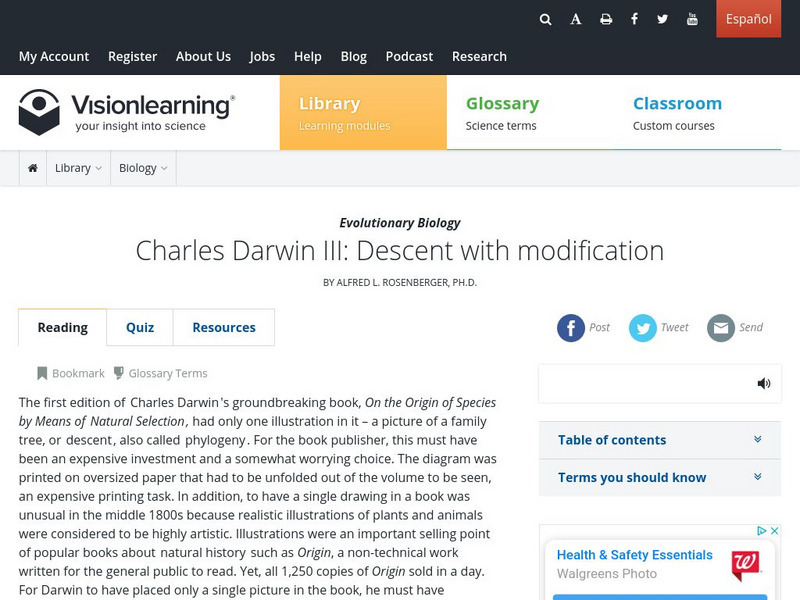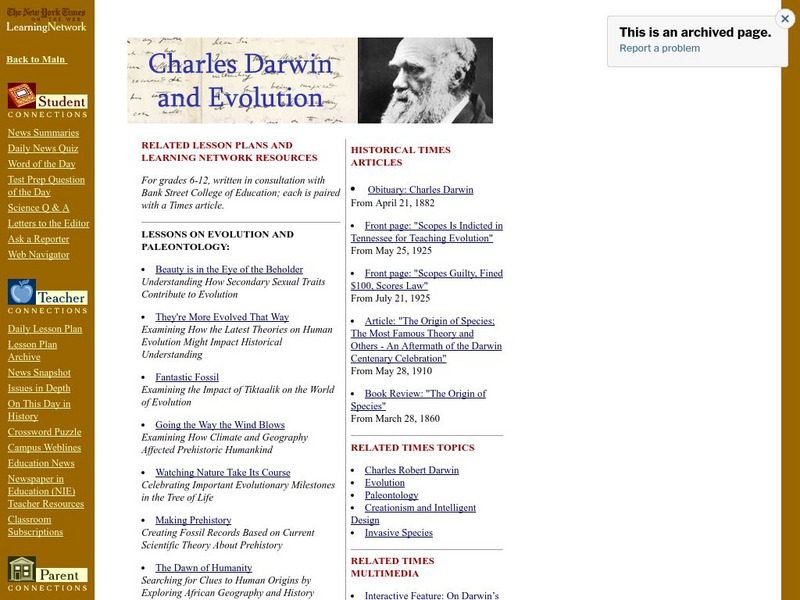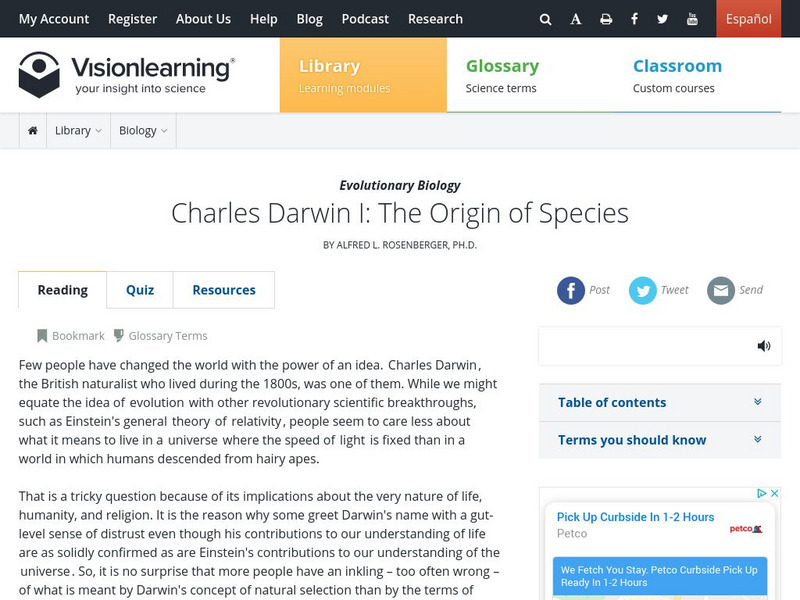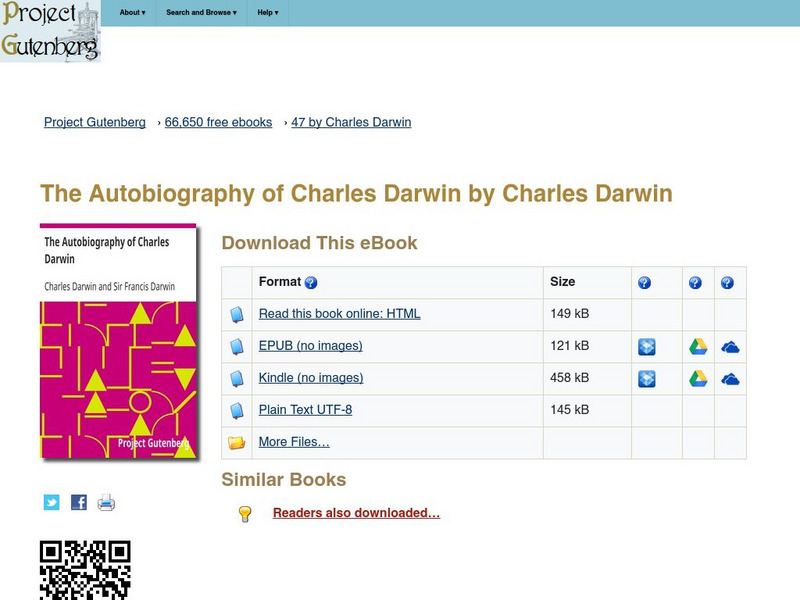Curated OER
Using Living Organisms to Explain Evolution
Students investigate evolution in its most fundamental form: the observation of living organisms. By comparing variations that exist among living animals, students formulate their own hypotheses and conclusions about the evolution of...
Curated OER
Natural Selection I
Eighth graders list the steps of Darwin's natural selection. They demonstrate the process of natural selection in a predation activity. Students create paper origami frogs to race across the floor and analyze the differences in the...
Curated OER
Evolution
In this evolution worksheet students complete a crossword puzzle by answering questions about the environment, evolution and populations.
Curated OER
How Life on Earth Began
Seventh graders investigate the concept of evolution and how it was a mechanism for the foundation of life on Earth. They conduct research and attempt to make cognitive connections with the evidence to agree with the presupposition of...
Curated OER
How Evolution Works
Students discuss the evolution of the eye and how a complex organ can evolve through natural selection. They research genetic variation, adaptation, and sexual selection. They analyze data to determine how beak length of Gal??pagos...
Curated OER
Biology: Natural Selection
Students explore evolutionary processes and theories using the spotted fish applet. They observe what happens to fish in a closed environment with both food and predators. Students run the model several times and answer questions about...
Curated OER
Struggle for Existence and Population Growth in Aphids
Pupils examine the population of aphids. They identify adaptations they have made for their environment. They make predictions, test their hypothesis and collect information that either proves or disproves their theory.
Curated OER
Natural Selection
Kids act as scientists and preditors in this short natural selection activity; they collect and analyze data, then apply their new knowledge to real-world examples of natural selection. The layout of the worksheet is easy enough to use...
Curated OER
The Roaring 20s Through Hoover (5)
In this online interactive American history worksheet, students answer 13 matching questions regarding 1920's America and the Hoover presidency. Students may submit their answers to be scored.
Curated OER
Candy Dish Selection
Students explore natural selection. They explore the concepts of adaptations, and the way which random factors affect the survival of individuals and populations.
Curated OER
Biology Chapter 15 Word Search Puzzle
For this biology worksheet, students look for the words that are related to the theme of the worksheet. They also work on the skills of spelling and word recognition.
Curated OER
ESL Conversations: Inventions and Inventors
In this ESL conversation worksheet, students work in pairs to ask questions in the passive form. Students use the sentences provided and change them to passive questions. All pertain to inventions. It is unclear if students are to answer...
Curated OER
Scientists and Inventors
Fourth graders investigate scientists and inventors. In this science lesson, 4th graders discuss inventors and scientists. Students research their chosen inventor or scientists and write a report about that person.
Vision Learning
Visionlearning: Biology: Charles Darwin Iii: Descent With Modification
Instructional module focusing on Charles Darwin's theory of Descent with Modification. Discusses how slight changes from parent to offspring create variation and potentially create new species over time. Site also includes an interactive...
Scientific American
Scientific American: Happy 200th Birthday Charles Darwin: In Depth Reports
Explore the thinking of Charles Darwin, and read how his theory of evolution survives, thrives, and shapes the way we learn about nature. (February 2009)
New York Times
New York Times: Charles Darwin and Evolution
An outstanding collection of materials for learning about Charles Darwin and Evolution. There are many different lessons on the topics of evolution, paleontology, biodiversity, and adaptation. Each lesson is paired with an actual New...
PBS
Pbs Online News Hour Extra: 200 Years Later, Darwin's Theories Still Inspire
Explore this concise article detailing Charles Darwin's Theory of Evolution and follow with discussion questions.
Cornell University
Cornell University: Library: Charles Darwin After the Origin
In honor of Darwin's 200th birthday and the 150th anniversary of the publication of "The Origin of the Species," Cornell has put together an extensive collection of Darwin's work during the last two decades of his life.
Vision Learning
Visionlearning: Biology: Charles Darwin I: The Origin of Species
Instructional module focusing on the early work of Charles Darwin. Discusses Darwin's key role in supporting and describing the theory of evolution as driven by natural selection. Site also includes an interactive practice quiz and links...
Famous Scientists
Famous Scientists: Charles Darwin
A short biography of Charles Darwin, and how he discovered evolutionary theory and natural selection.
The History Cat
The History Cat: Charles Darwin & the Theory of Evolution
Outlines the events of Charles Darwin's own evolution into a scientist and how he developed his Theory of Evolution. Also discusses the immense resistance to his ideas that he faced from all fronts. Even today, many people refuse to...
PBS
Pbs Learning Media: Darwin's Letters: Collecting Evidence
This group of letters is a sample of the extensive correspondence Darwin carried on with a wide group of friends and colleagues as he collected evidence to support his theory of evolution by natural selection. From Charles Darwin's...
PBS
Pbs Learning Media: Darwin's Diary
At the online companion Web site of "Evolution," the seven-episode series on PBS, delve into the private thoughts of a reluctant revolutionary--Charles Darwin.
Project Gutenberg
Project Gutenberg: The Autobiography of Charles Darwin
Resource presents multiple digital formats of this literary text. You can read about the famous scientist's life in his own words, as he recalled his thoughts and actions for his children.



















